FOLKoLOVE

Bei Natibaby haben wir eine Leidenschaft für volkstümliche Muster. Volksmuster sind schön, verziert und fröhlich, sie eignen sich perfekt für Tragetücher und Babytragen. Viele unserer Folk-Muster haben wir zusammen mit interessierten Müttern entworfen, die ihre regionale Zugehörigkeit zeigen und ihre Umgebung sowie die einzigartige Kultur fördern wollten. Die Ergebnisse präsentieren wir in diesem Beitrag.
Stickerei in Kaschubien
Unsere Reise durch Polen beginnt im Norden – willkommen in Kaschubien. Unser Muster Kaszuby und Kaszuby Night basiert auf Motiven der kaschubischen Stickerei. Die Geschichte der Stickerei ist eng mit den Klöstern in Kaschubien verbunden. In früheren Zeiten lehrten Nonnen in klösterlichen Schulen wohlhabende Mädchen das Nähen und Verzieren von Kleidern mit Stickereien. Die Schülerinnen sollten sich von den Mustern anderer Regionen inspirieren lassen, in denen sich Norbertiner- und Benediktinerklöster befanden, hatten aber auch kreative Freiheit, was zur Entstehung der kaschubischen Stickerei führte. Charakteristisch für diese Stickerei ist die Verwendung von einigen Grundfarben: Schwarz, Rot, Grün, Gelb und Blau in drei Schattierungen. Am häufigsten sind Blumenmotive, die aus der umliegenden Landschaft stammen – Kleeblätter, Lilien, Vergissmeinnicht, Rosen, Stiefmütterchen, Kornblumen, Nelken sowie fremde Motive, die in den Klöstern eingeführt wurden – Tulpen, Akanthus, Palmetten und Granatapfelblüten.
.jpg?1573734288291)
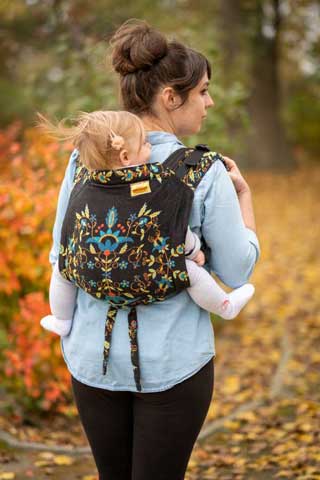
Łowicz Folk Muster
Wir reisen weiter südlich und besuchen die Region Łowicz im Zentrum Polens. Das erste Tragetuchmuster von Natibaby, inspiriert von polnischer Volkskunst, entstand bereits 2013. Im Laufe der Jahre entstanden fast 20 Farbversionen! Besonders beliebt waren Kombinationen von grauem Hintergrund mit bunten Mustern.
Die beliebten Volksmuster entstanden ursprünglich auf Alltagsgegenständen und Festtagskleidung. Töpferwaren, Keramik, Lederwaren, Gusswaren, Schmiedewaren und Textilien wurden mit diesen Mustern verziert. Die Muster wurden gewebt, gestickt und es entstanden wunderschöne, zarte Spitzen.
Łowicz-Muster wurden aufgrund ihrer einzigartigen Komposition und wiederkehrenden Blumenmotive sowie charakteristischen Darstellungen von Hähnen sehr beliebt. Unsere Versionen konzentrieren sich auf einige Farbkombinationen, die entsprechend zum Hintergrundfarbe ausgewählt werden, um die Komposition und die einzigartige Zeichnung hervorzuheben.
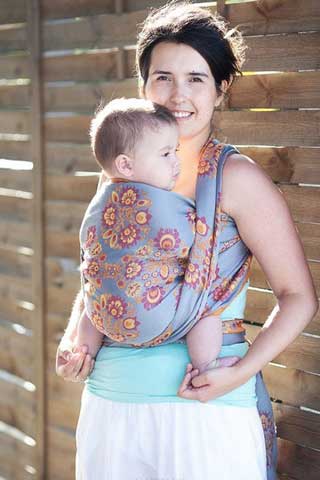
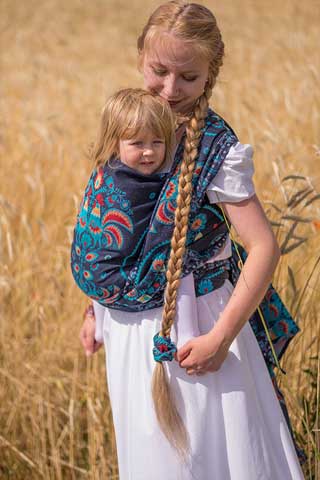
Engagiert und nah am Herzen… Ein paar Worte zu Kroszonka und Folk aus Opole
Wir wenden uns nach Westen und erreichen die Region Opole. Diese Region kann sich einer einzigartigen Technik zur Herstellung von Ostereiern rühmen. Kroszonka ist eine Methode, Ostereier (geblasene Eier) zu verzieren, indem Muster auf der gefärbten Eierschale "gekratzt" werden. Auf diese Weise entstehen Gravuren mit Pflanzenmotiven: Blumen, Palmen, Blätter usw. Traditionelle Kroszonki waren einfarbig, wodurch die Komposition in den Vordergrund trat. Sie ist beeindruckend, ausdrucksstark und reichhaltig, sehr kleine Elemente bilden komplizierte Zusammenstellungen. Kratzmuster erzeugen eine Illusion von Dreidimensionalität, einzelne Ebenen sind leicht erkennbar. Das Erstellen einer symmetrischen und so klaren Komposition erfordert meisterhafte Präzision, und das Ergebnis ist atemberaubend. Kroszonki wurden so beliebt, dass man nach neuen Exportprodukten für diese Ornamente suchte. Es wurde Porzellan, das mit kleinen Blumenmustern inspiriert von Kroszonka bemalt wurde, jedoch im Vergleich zu Kroszonka waren die Muster mehrfarbig.
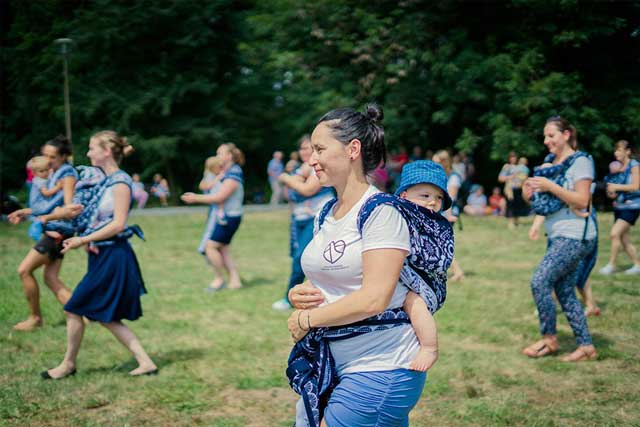
Foto: Gracja Krawczyk
Mitglieder des Vereins „Zamotani - Blisko Serca“ aus Opole nahmen gemeinsam einen Tanz der Mütter in Natibaby-Tragetüchern und Babytragen im wunderschönen Kroszonka-Muster für einen Tesco-Wettbewerb auf. Die Mädchen sahen wunderbar aus. Dieser Wettbewerb war eine weitere Gelegenheit, sich zu treffen, zu tanzen und aktiv Zeit mit ihren Kindern zu verbringen. Sie führten den Tanz auch auf einem Picknick auf, das im Sommer in Opole stattfand.
Minimalismus aus dem Vorland der Beskiden
Wir erreichen den Süden Polens, genauer gesagt das Gebiet des Vorlandes der Beskiden. Die Volkskostüme dieser Region waren wunderschön mit Pflanzenmotiven verziert. Die Komposition ist nicht überladen, man spürt deutlich den Raum, die Muster überwältigen nicht. Die Blumenstiele winden sich anmutig und bilden ein harmonisches Ganzes. Die Spitzen, die uns inspirierten, sind zart, die Blumen klein und leicht, manchmal kaum wahrnehmbar. Minimalismus in dieser Form ist die Quintessenz der Eleganz.

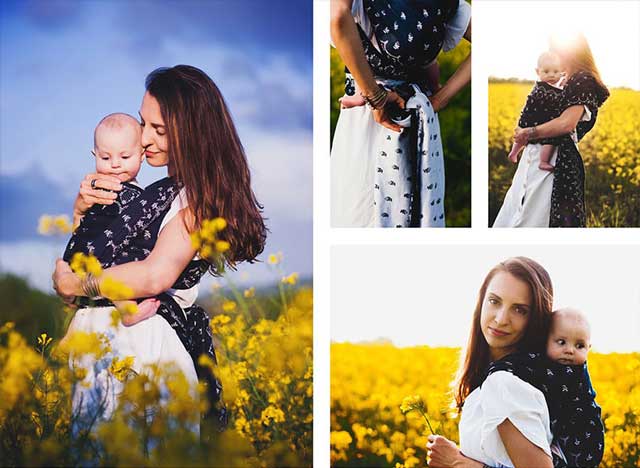
Foto: Karolina Chrapkiewicz
Schöne Tragetücher in der Bergversion
Wir erreichen die Berge, begleitet von wechselhaftem und unvorhersehbarem Wetter. Auf solches Wetter waren die einheimischen Bergfrauen immer vorbereitet und trugen daher Tücher. Barankula, auch Baraniato genannt, war ein teures, dekoratives Tuch mit Fransen, normalerweise schwarz und für den Winter gedacht. Die Inspiration für dieses Muster waren die Bergtücher, aber wir vertieften uns weiter und übernahmen die Namen der einzelnen Farbversionen aus dem Hochland-Dialekt. Die Muster hießen Corny (Schwarz), Pikno (schön), Hruby (dick, reich), Biola (weiß). In der Komposition dominieren Blumenmotive, selbst in den Volkstrachten der Männer.
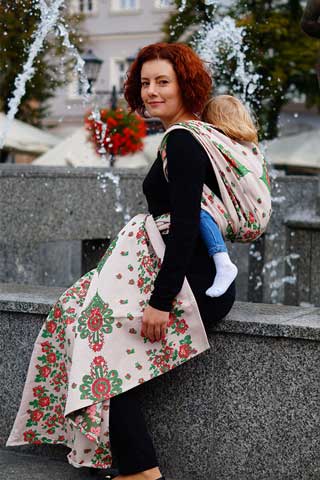

Wie man sieht, wohin auch immer man reist, Polen ist voller Inspirationen. Man muss nicht weit suchen. Polen hat eine sehr reiche Kultur und eine lange Geschichte, daher ist es nicht verwunderlich, dass die einzelnen Regionen ihre eigenen Muster und Motive haben, die die Bewohner eines bestimmten Gebiets von anderen unterscheiden sollten. Viele dieser Muster sind in die Geschichte des Designs eingegangen, und einige davon haben uns zur Schaffung von Stoffen für Tragetücher, Babytragen und Accessoires inspiriert. Indem wir das Beste aus unserer Kultur schöpfen, stellen wir sicher, dass sie lebt und von unseren Kindern nicht vergessen wird. Wir werden auch weiterhin gerne Muster für Tragetücher und Babytragen inspiriert von polnischem Design mitgestalten, wie wir es bisher getan haben, in der Hoffnung, dass sie die ganze Welt bezaubern.

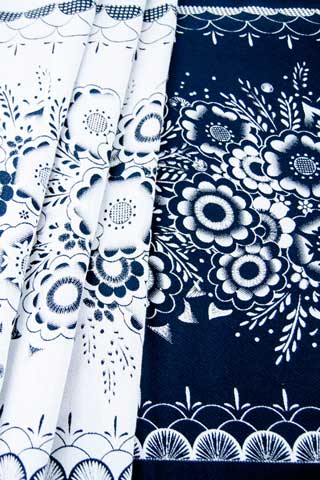

 Polnisch
Polnisch
 Englisch
Englisch